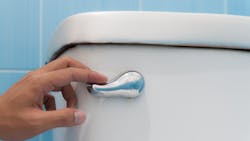Research accelerates on-site urine treatment for reuse
Researchers developing a technology that can treat urine for reuse on-site rather than at a centralized wastewater treatment facility, according to a press release by West Virginia University.
The technology could reside underneath a toilet, enabling urine treatment to happen quickly and promoting the recovery of nitrogen. The latest findings improve a key process in the technology: the speed at which an on-site design can treat urine.
The findings, published in the journal Environmental Technology, make urine recycling more feasible in terms of integration into existing infrastructure and could reduce the amount of nutrients that enter lakes and rivers. Excessive nutrient discharge can put aquatic ecosystems at risk by promoting the growth of algae that consume dissolved oxygen in the water.
The goal is to transform waste collection and treatment from an environmentally harmful service that costs money to an environmentally beneficial service that makes money.
Kevin Orner, assistant professor for the department of civil and environmental engineering and co-author of the study, envisions toilets that separate urine and feces, allowing each of those waste products to be collected, treated, and converted into a useful commercial product — most commonly, as agricultural fertilizer.
The Findings
The approach Orner sees as most viable requires no power to operate. A urine-separating toilet’s design separates solids from liquids, then sends the urine to a nutrient recovery unit that’s located in or attached to the toilet itself, or potentially housed in a residential or commercial basement.
But speed is essential to large-scale implementation. Since toilets typically receive several doses of urine throughout the day, the urine has to get treated quickly so it can be released into another unit to make room for the next dose — especially in a system that’s small enough to attach to a toilet.
The researchers’ work accelerates the processing of urine. By priming the collection and treatment reservoir with an inoculation of soil containing helpful microorganisms, adding in carbon pellets to provide a growing surface for bacteria that are key to the treatment process, and using a fill-and-draw procedure whereby small quantities of treated urine are removed and fresh urine is incrementally added, his team was able to significantly accelerate treatment — reducing a process that could take weeks down to a day in one phase of the study.
Societal Adoption
Circular sanitation isn’t yet on the cusp of becoming the new normal. High-end urine-separating toilets appear almost identical to current toilets but can be expensive. Cheaper versions can have odors or require users to adopt new behaviors.
Underdeveloped policies around urine-derived fertilizer products are another barrier. And Orner pointed out that most communities’ building codes don’t consider this kind of technology in their permitting guidelines, although he has worked with the Gold Ribbon Commission on drafting regulations for adoption by state or local governments.
However, these urine-separating toilets exist — not only in Kenya and Vermont, but from Oregon to Paris and the Netherlands. Orner has a collaborator in Costa Rica who “is interested in taking the lessons learned from Brattleboro and applying those to Monteverde, an ecotourism community in the Cloud Forest,” Orner says.
“Of course, there’s the ‘ew’ factor in dealing with urine,” he adds, “but, in fact, urine isn’t a waste. It has value.”
